
Industry Standard Architecture (ISA) is the 16-bit internal bus of IBM PC/AT and similar computers based on the Intel 80286 and its immediate successors during the 1980s. The bus was (largely) backward compatible with the 8-bit bus of the 8088-based IBM PC, including the IBM PC/XT as well as IBM PC compatibles.
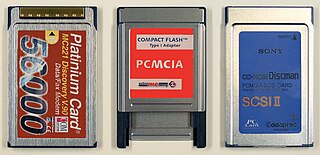
PC Card is a parallel peripheral interface for laptop computers and PDAs. The Personal Computer Memory Card International Association (PCMCIA) originally introduced the 16-bit ISA-based PCMCIA Card in 1990, but renamed it to PC Card in March 1995 to avoid confusion with the name of the organization. The CardBus PC Card was introduced as a 32-bit version of the original PC Card, based on the PCI specification. The card slots are backward compatible for the original 16-bit card, older slots are not forward compatible with newer cards.

The Memory Stick is a removable flash memory card format, originally launched by Sony in late 1998. In addition to the original Memory Stick, this family includes the Memory Stick PRO, a revision that allows greater maximum storage capacity and faster file transfer speeds; Memory Stick Duo, a small-form-factor version of the Memory Stick ; the even smaller Memory Stick Micro (M2), and the Memory Stick PRO-HG, a high speed variant of the PRO to be used in high-definition video and still cameras.

A memory card is an electronic data storage device used for storing digital information, typically using flash memory. These are commonly used in digital portable electronic devices, such as Digital cameras as well as in many early games consoles such as the Nintendo Wii. They allow adding memory to such devices using a card in a socket instead of protruding USB flash drives.
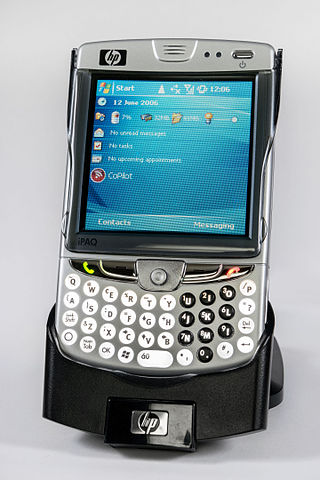
The iPAQ is a discontinued Pocket PC and personal digital assistant which was first unveiled by Compaq in April 2000.
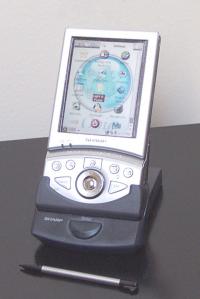
The Sharp Zaurus is the name of a series of personal digital assistants (PDAs) made by Sharp Corporation. The Zaurus was the most popular PDA during the 1990s in Japan and was based on a proprietary operating system. The first Sharp PDA to use the Linux operating system was the SL-5000D, running the Qtopia-based Embedix Plus. The Linux Documentation Project considers the Zaurus series to be "true Linux PDAs" because their manufacturers install Linux-based operating systems on them by default. The name derives from the common suffix applied to the names of dinosaurs.

CompactFlash (CF) is a flash memory mass storage device used mainly in portable electronic devices. The format was specified and the devices were first manufactured by SanDisk in 1994.

Secure Digital, officially abbreviated as SD, is a proprietary, non-volatile, flash memory card format the SD Association (SDA) developed for use in portable devices.

A camcorder is a self-contained portable electronic device with video and recording as its primary function. It is typically equipped with an articulating screen mounted on the left side, a belt to facilitate holding on the right side, hot-swappable battery facing towards the user, hot-swappable recording media, and an internally contained quiet optical zoom lens.
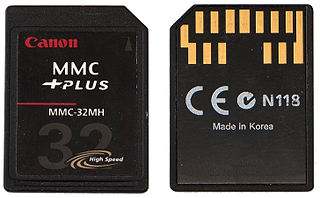
MultiMediaCard, officially abbreviated as MMC, is a memory card standard used for solid-state storage. Unveiled in 1997 by SanDisk and Siemens, MMC is based on a surface-contact low pin-count serial interface using a single memory stack substrate assembly, and is therefore much smaller than earlier systems based on high pin-count parallel interfaces using traditional surface-mount assembly such as CompactFlash. Both products were initially introduced using SanDisk NOR-based flash technology.
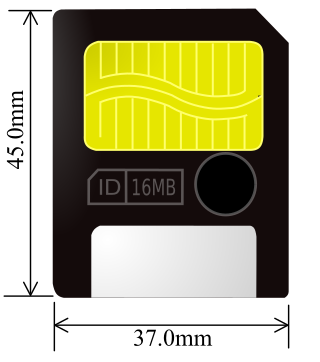
SmartMedia is an obsolete flash memory card standard owned by Toshiba, with capacities ranging from 2 MB to 128 MB. The format mostly saw application in the early 2000s in digital cameras and audio production. SmartMedia memory cards are no longer manufactured.

The xD-Picture Card is an obsolete form of flash memory card, used in digital cameras made by Olympus, Fujifilm, and Kodak during the 2000s. The xD in the xD-Picture Card stands for eXtreme Digital.

Hi-MD is a magneto-optical disc-based data storage format. It was a further development of the MiniDisc. With its release in later 2004, came the ability to use newly developed, high-capacity 1 gigabyte Hi-MD discs, in the same dimensions as MiniDisc. The last recorder and player was discontinued in 2011. Blank discs stopped production in September 2012.
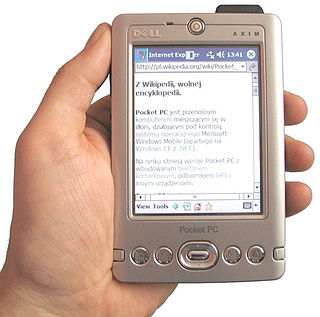
The Dell Axim family of personal digital assistants was Dell's line of Windows Mobile-powered Pocket PC Devices. The first model, the Axim X5, was introduced in 2002, while the final model, the Axim X51, was discontinued on April 9, 2007.

Linear Flash is a PC card flash memory format. Linear Flash requires no battery support, unlike somewhat faster SRAM, and features read/write speeds much faster than similar, less expensive ATA-type cards, which include CompactFlash and Memory Stick. Like an SRAM, Linear Flash supports execute in place (XIP) applications in mobile PC and embedded equipment.

P2 is a professional digital recording solid-state memory storage media format introduced by Panasonic in 2004. The P2 card is essentially a RAID of Secure Digital (SD) memory cards with an LSI controller tightly packaged in a die-cast PC Card enclosure. The system includes cameras, decks as drop-in replacements for videotape decks, and a special 5.25-inch computer drive for random-access integration with non-linear editing systems (NLE). The cards can also be used directly where a PC card (PCMCIA) slot is available, as in most older notebook computers, as a normal hard disk drive, although a custom software driver must first be loaded.
The PocketZip is a medium-capacity floppy disk storage system introduced by Iomega in 1999. It uses very small 40 MB disks. It was originally known as the "Clik!" drive until the click of death class action lawsuit regarding mass failures of Iomega's original Zip drives, after which it was renamed "PocketZip". In 2001, the company announced bigger-capacity 100 MB disks, which were never released.

The Jornada was a line of personal digital assistants or PDAs manufactured by Hewlett-Packard. The Jornada was a broad product line that included Palm-Size PCs, Handheld PCs, and Pocket PCs. The first model was the 820, released in 1998, and the last was the 928 model in 2002 when Compaq and HP merged. The Jornada line was then succeeded by the more popular iPAQ model PDAs. All Jornada models ran Microsoft Operating Systems that were based on Windows CE.

The Philips Velo was a Handheld PC.

Eye-Fi was a company based in Mountain View, California, that produced SD memory cards with Wi-Fi capabilities. Using an Eye-Fi card inside a digital camera, one could wirelessly and automatically upload digital photos to a local computer or a mobile device such as a smartphone or tablet computer. The company ceased business in 2016.




















